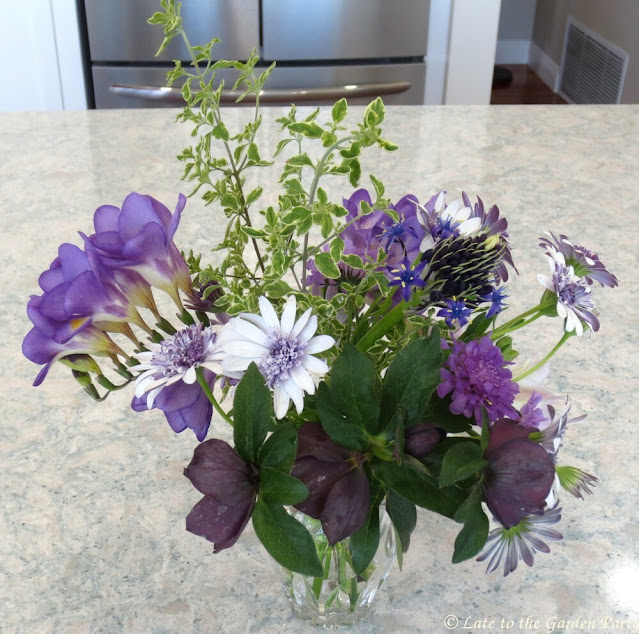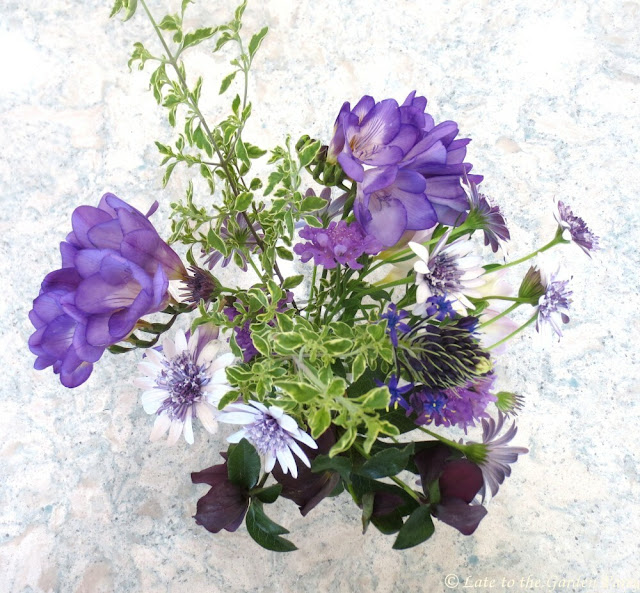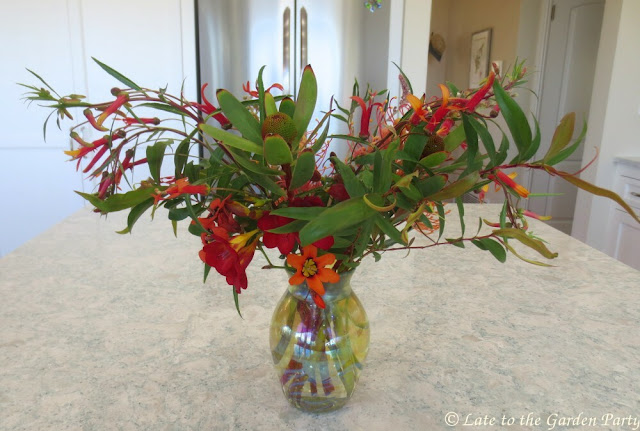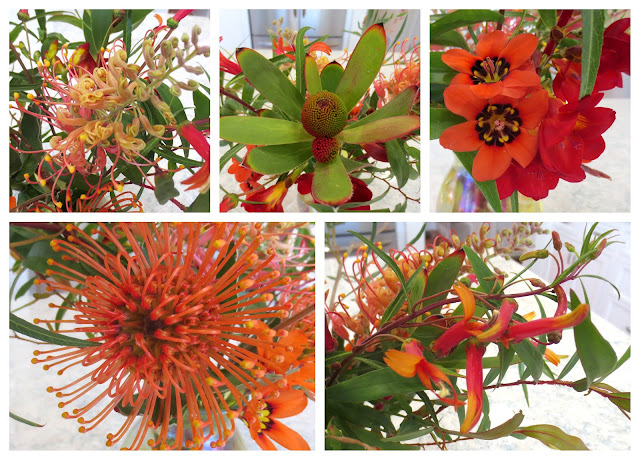The area on the west side of the garage, sandwiched between the hedge that fronts the street and and the driveway, was the last area we addressed in our campaign to remove all our lawn after moving in. In addition to the fact that we were running out of steam at that point, the area has been a challenge from the start. Finding the right mix of plants has been difficult, complicated by a good deal of shade and soil riddled with roots from the hedge and four surrounding trees.
 |
| This photo, taken at the end of March 2019, shows the area at its best. We had heavier-than-usual rain leading into spring that year. |
By way of history, we didn't begin addressing this area until September 2015.
 |
| This photo was taken in September 2015, just before the sod was stripped away. The roses on the right and the pineapple guava tree, Pittosporum shrubs and some Japanese anemones on the left came with the garden. |
 |
| This was the area immediately after it was stripped of sod. We spent the next couple of months clearing the soil of the sod's plastic netting, rocks, and plant roots before adding topsoil and a flagstone path. |
 |
| This is the area after I replanted it in March 2016. Some of the plants, including the Festuca 'Festina', creeping thyme, Moroccan daisies (Pyrethropsis hosmariense) , and Renga lilies (Arthropodium cirratum) remain but the Cyclamen, Heuchera and Violas I originally planted are long gone. |
 |
| This path, created to move the garbage and recycle bins to the street for pickup, was one of my husband's pandemic projects in early 2020. (Note: the succulent bed on the right side of the path is not a addressed in this particular post) |
Instead of changing out three or fewer plants at a time as I've been doing, I decided the area needed a more extensive makeover, although I wasn't prepared to pull everything out and start all over so I'm calling this latest effort a refresh rather than a wholesale renovation.
 |
| This photo, taken for a wide shot post in October 2021, is the best I can offer of the area in its "before" state |
 |
| This photo, taken last week, shows some of the shrubs that particularly bothered me prior to starting my "refresh" |
I'd already removed the coleus (Plectranthus scutellarioides) shown in October's wide shot when I took the last photo shown above but I dug out three Duranta erecta and the floppy Polygala fruticosa late last week. After adding soil amendments, I filled in with recent purchases and some seedlings. The replanted area still looks bare but hopefully the new plants will bulk up within the next couple of years.
 |
| This is an "after" shot taken yesterday, looking roughly northwest |
 |
| This "after" shot was taken from the area's other end, looking southeast |
 |
| Three new Polygala fruticosa 'Petite Butterfly' shrubs were added at the north end. These are supposed to be dwarfs but I know from experience they can get bigger than their projected profile. They're attractive plants and I love their flowers so I hope I can keep them within bounds this time with regular pruning. |
 |
| I added Stachys byzantina and Saxifraga stolonifera here to fill in among the existing hellebores and Renga lilies surrounding the pineapple guava tree |
 |
| I added a barely visible Boronia crenulata shrub, Gaura lindheimeri and groundcover Erodium here to fill spaces in between daylilies, Renga lilies and Cuphea 'Starfire Pink' |
 |
| I removed a large clump of Aeonium arboreum that was crowding the Festuca california and a Dombeya burgessaiae in this area. That removal also uncovered two Veltheimia bracteata I thought I'd lost. |
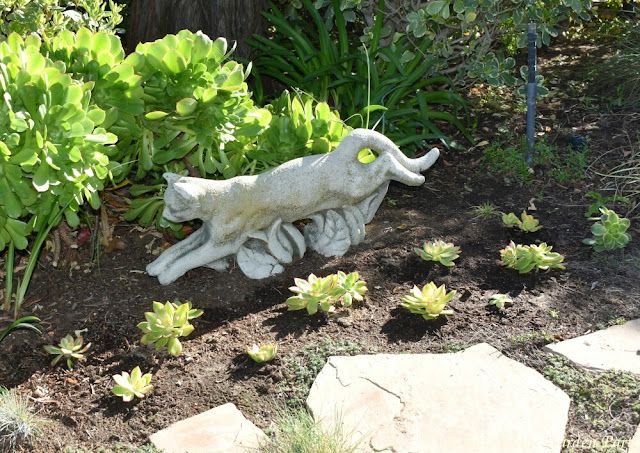 |
| I also cut back the Aeonium arboreum that had half-hidden this cat sculpture, a gift from my husband years ago. I filled the area in front of it with cuttings of Aeonium haworthii 'Kiwi', a more well-behaved succulent. |
A passalong gift of the Dombeya burgessaiae late last year started my reexamination of the area. I decided to lean into a pink, purple and white color theme with my subsequent plant choices.
 |
| The Dombeya was passed to me by Denise of A Growing Obsession. She'd had it in a pot but thought it might prefer a spot in the ground. I gave it that here but was concerned whether it would be a good fit. It seems happy enough thus far. It's even developing flower buds. |
 |
| Clockwise from the upper left, a closer look at the new plants: Boronia crenulata 'Shark Bay' (2), Gaura lindheimeri 'White Dove' (3), Pacific Coast Iris* (5), Polygala fruticosa 'Petite Butterfly' (3, aka sweet pea shrub), Saxifraga stolonifera (3, aka strawberry geranium), and Stachys byzantina 'Helen von Stein' (5, aka lambs ear). I also planted 2 6-packs of Erodium 'Bishop's Form' (not shown). *The Iris were sold as 'Wilder than Ever' but the first to bloom isn't that cultivar. |
The seedlings I added are still tiny but, as there's little rain in the future forecast, I decided they'd have a better chance of survival in the ground where they'll receive irrigation on a regular schedule than in pots, dependent upon me for keeping them watered as temperatures start to climb. I didn't take photos of the seedlings but they included Echium handiense (3), Paeonia cambessedesii (4, aka Majorcan peony), and Plectranthus zuluensis (2). I potted up several peony seeds a year and half ago and was surprised when some germinated but, still small, they died back in the summer just as the parent plant does. They recently reemerged, still small, so into the ground they went. They may not make it but I remain hopeful.
I left a lot of plants in place, only a small number of which I photographed for this post.
 |
Top row: Arthropodium cirratum (aka Renga lily), Cuphea 'Starfire Pink', and Daphne odora
Second row: Festuca californica, Freesia, and Lomandra 'Platinum Beauty'
Third row: Lavandula stoechas, Limonium perezii, and Pyrethropsis hosmariense (aka Rhodanthemum and Moroccan daisies) |
Existing plants not shown in close up photos include the following:
- Acer palmatum 'Sango Kaku (1)
- Arctotis 'Opera Pink' (3)
- Barleria obtusa (1 clump)
- Carex 'Eversheen' (5)
- Eriocapitella hupehensis (3 or more, aka Japanese anemone, currently dormant)
- Feijoa sellowiana (1, aka pineapple gauva)
- Festuca cineria 'Festina' (12+)
- Freesia (numerous in blue, pink and white)
- Helleborus 'Pacific Frost', 'Wedding Bells', 'Confetti Cake', 'Flower Girl', and 'True Love'
- Hemerocallis 'Apollodorus', Joan Senior' (2), 'Plum Perfect' (3), and 'Prairie Moonlight'
- Hypoestes aristata (1, aka ribbon bush)
- Iris douglasii 'Santa Lucia' (several in addition to those purchased recently, aka Pacific Coast Iris)
- Oenothera speciosa (numerous, self-seeded plants)
The above list is as much for my own reference as it is for general interest. While I've had some success with hellebores and daylilies elsewhere in my garden, these plants are questionable selections for this area, especially as rain levels remain low. If they don't do well over the next few years, they'll be out in a future "refresh."
This project was the focus of my efforts in my garden this week, undertaken in part to distract my attention from newscasts reflecting the upheaval in Europe instigated by an authoritarian bully seeking to dominate his neighbor. As that bully escalates his meritless claims, my heart is with the Ukrainian people and their desire for peace without relinquishment of their rights.
All material © 2012-2022 by Kris Peterson for Late to the Garden Party




